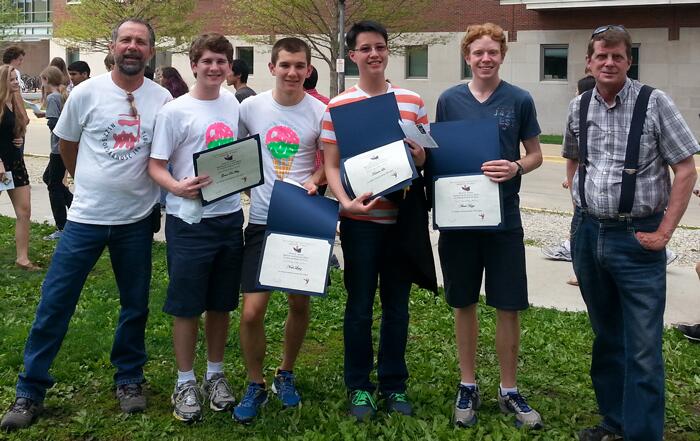AMD Laser Projection Pen

Wylde Q. Chicken Award Winners
Left to right: Grant DeAtley, Noah Lopez, Darren Liu, & Ansel Higgs.
Flanked by Class of '72 Representatives Rob Zych & Scott Wyatt
Our project started as a pretty basic assignment in the spirit of engineering for Dr. Denos' first semester senior-level Engineering Explorations class. In a group, we were assigned to go through the process of solving a problem up to the prototyping stage. Each group had to come up with a way to give someone afflicted with Macular degeneration, a condition that affects the eyesight, the ability to write legibly.
This problem was personal for Dr. Denos because her mother was a victim of Macular degeneration and experienced the difficulty of adjusting her lifestyle around the condition. The closeness to the problem at hand really helped us empathize and gave us more reason to put our efforts into the project.
Our group came up with a fairly simple solution. Macular degeneration (AMD) attacks the center of the vision, slowly distorting and eventually making the center of vision fade away. However, the peripheral vision isn't affected to the same degree and victims of the disease still have limited vision in the periphery. Writing is difficult for people with AMD because they can't see what they're writing. The body naturally puts what is being written in the center of vision, which is where the patient's vision is the poorest. Because AMD manifests itself usually later in life, it's difficult to break the old habits and muscle memory, making transitioning to a new way of writing challenging. What if what was being written in the parts of the vision that was obstructed could be shown in the periphery? Could this be done without changing the learned habits from muscle memory?
By asking these questions we were able to come up with a solution. A pen with a laser pointer attached at an angle, to project the shapes one is drawing into the peripheral vision solved the legibility problem perfectly. The bright light of a laser would be much easier for people to see on a writing surface and the shapes of letters would be easier to imagine with the simple aid.
From there we started making prototypes. From popsicle sticks to 3D-printed PLA, our prototypes slowly began to get better and better. We took the project a step further when we actually created the product using Uni's 3D printer donated by alumnus Blaine Garst. This proved to be an excellent idea, as our group members were already comfortable with using advanced modeling software and 3D printing in general. With access to the printer, we were able to make better and better prototypes through trial and error.
Through our efforts we hope to eventually bring our solution to actual victims of AMD and to make a positive difference in their lives.